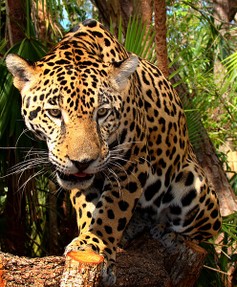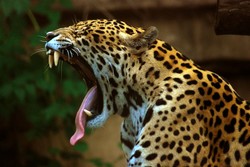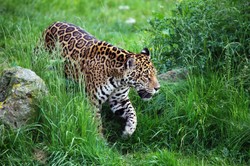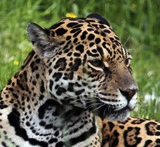The jaguar is sometimes confused with the leopard because both have spots in rosettes but those of the jaguar have a black spot at the center.
The yellowish buff ground color is similar in both, but in the jaguar the rosettes tend to be concentrated along the back. The belly and chest are pale and have irregularly placed black spots, and the lower half of the tail is ringed. There is a black mark near the mouth on the lower jaw, and the backs of the ears are black. The variations in color range from an almost white ground color to black forms, in which the rosettes can only be seen as a variation in texture. Jaguars vary in size from 3.9 to 6.4 feet overall.




 The jaguar demonstrates remarkable strength, and has been recorded as pulling a dead horse through 70 yards of brush and then towing it across a river. It does not appear to have the same reputation for man-eating as many of the African and Asian cats, but this could well be because the area in which the animal lives has not yet been exploited to the same degree as have the habitats of the other cats. Jaguars will also eat carrion and they are often lured into traps by this means.
The jaguar demonstrates remarkable strength, and has been recorded as pulling a dead horse through 70 yards of brush and then towing it across a river. It does not appear to have the same reputation for man-eating as many of the African and Asian cats, but this could well be because the area in which the animal lives has not yet been exploited to the same degree as have the habitats of the other cats. Jaguars will also eat carrion and they are often lured into traps by this means.

 Confuciuson 02/03/2013
Confuciuson 02/03/2013
 Hiking the Appalachian Trailon 08/31/2012
Hiking the Appalachian Trailon 08/31/2012
 Rent College Textbookson 08/10/2012
Rent College Textbookson 08/10/2012
 Establishing Quiet Hour for College Studentson 12/16/2011
Establishing Quiet Hour for College Studentson 12/16/2011



Comments